Saltwater Fish Species - South Atlantic, Gulf of Mexico & the Caribbean

Species > Saltwater
Common sport fish, bait fish and other species listed in alphabetical order with sections for major species like grouper and snapper. Brief details on where to find each species, what they eat
and the bait to use can give you the upper hand in catching your target species. If you cannot find a fish on this page, visit MBARA's photo albums of tropical fish for species found on reefs, non-sport fish. ![]() Fish Identification Saltwater shows drawing of common Florida fish.
Fish Identification Saltwater shows drawing of common Florida fish.
![]() = Bait Fish
= Bait Fish ![]() =Protected Species
=Protected Species
 Anchovy, Bay
Anchovy, Bay 
Bay Anchovy's are schooling bait fish found in bays and deep water. They are usually 4 inches long and easily caught by cast net. Anchovies feed mostly on zooplankton, which are microscopic animals like fish larvae. They are a favorite of striped bass, bluefish and weakfish. Photo Courtesy of Nicholls.edu
Atlantic Threadfin see section below
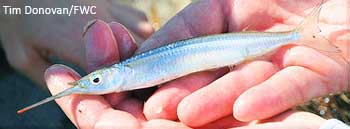 Ballyhoo (Hemiramphus sp.)
Ballyhoo (Hemiramphus sp.) 
Ballyhoo is a popular bait fish for trolling or as cut bait. The Ballyhoo can grow to 16 inches, but are commonly 12 inches. There are usually found in the warmer southern Florida waters. Ballyhoo respond easily to ground chum and once they are schooled, cast netting is the way to capture more of them. You can also catch them with tiny hooks and small bits of cut bait or shrimp; Sibiki Rigs work well too. ![]() How to Rig a Ballyhoo on a Circle Hook
How to Rig a Ballyhoo on a Circle Hook
 Barracuda, Great
Barracuda, Great
The Great Barracuda is the only species of this large family located in Florida waters. The Great Barracuda can grow to 51 pounds and over 6 feet in length; most caught in Florida average 2 to 3 feet and 5 to 20 pounds.
Barracuda's are found offshore all over Florida traveling alone or in loose schools in open waters and lurking around reefs looking for the opportunity to ambush prey. This fish has been know to jump in boats chasing after your fish as you reel it in or after something shinny they desire. Barracudas can swim over 25 miles per hour! They have very big, sharp teeth which should be avoided. Barracuda is good eating, most cut them into steaks and grill, or you could smoke the meat which is very good.

 Bluefish
Bluefish
Bluefish move into Florida waters from the north Atlantic during the winter months and are a popular game fish. Bluefish swim in schools of similarly sized individuals usually behind large schools of bait fish. Bluefish grow up to 20 pounds and 40 inches long. Bluefish have very sharp teeth used to feed on squids and schooling fishes. Cut bait chumming with Menhaden, Mullet, Herring, Spot, whole Ballyhoo or Mackerel works great to draw this fish to your line. Use wire leaders to prevent this fish's sharp from cutting your line. Porgies, Mackerel and Sand Eels are great bait for catching this powerful fish. The flavor of the Bluefish's flesh is strong and best eaten freshly fillets gently sauted in butter with fresh garlic.
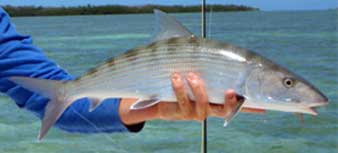 Bonefish
Bonefish
The elusive Bonefish travel in loose schools feeding on shrimp, shellfish, crabs, and fish from the bottom and from mangrove roots. The Bonefish inhabit shallow backwater among mangroves moving onto shallow mud flats to feed with the incoming tide, and retreating to deeper waters as the tide goes out. During the hot summer months Bonefish will move into deeper channels adjacent to flats. Chumming with bits of shrimp up current from their favorite hangouts proves very successful especially in very hot or cold temperatures. Bonefish a favorite for fly angers and are not commonly eaten. Since Bonefish feed by smell, crushing live shrimp to release more scent is a proven method to attract them. The best times to catch a Bonefish is during overcast sky, a rising tide, water less than 3 feet and water temperature more than 70 degrees. The average size of bonefish in South Florida and the Florida Keys range from 6-9 pounds and 10-12 pound bonefish are common. Photo Courtesy of Captain Eric Ryan, Key West Flats Fishing
 Bonito, Atlantic
Bonito, Atlantic 
The Atlantic Bonito is from the Mackerel family often confused with the Little Tunny Bonito. This fish grows to 30 inches and 12 pounds, has a compressed body with distinct vertical stripes, and has no teeth on the roof of it's mouth. Not good table fare, this fish is best used for baiting larger species like Shark.
 Bonito (False Albacore, Little Tunny)
Bonito (False Albacore, Little Tunny)
Bonito travel in large schools sometimes a half mile square. Most anglers catch Bonito while fishing for Kingfish; Bonito will hit on any bait if they are in the area. This fish is fun once hooked because it puts on an aggressive, furious fight.
The Bonito is in the Tuna family and is not commonly eaten in Florida due to it's size which is 4 to 15 pounds. You can identify the Bonito called False Albacore or Little Tunny by it's spots on the belly (not visible in this picture but there) and they do not have stripes but a wavy blue and silver pattern on their tops. This Bonito is similar to the Atlantic Bonito in structure and often misidentified. The Atlantic Bonito is from the Mackerel family and is not palatable where the Little Tunny Bonito is excellent eating because it's from the Tuna family. The bloody red meat of this Bonito must be bled in ice water for hours and the thick blood line must be removed before cooking it like any other Tuna. For more information visit Anglers Trash Sushi Grade Tuna.
Bonito feed on herrings, menhaden, hake, mackerels, anchovies, shrimp and squid. Bonito is a popular bait for Billfish, Kingfish and Sharks used by tournament anglers who go out the day before the big day and catch Bonito offshore for live bait during their tourney.
 Bumper, Atlantic
Bumper, Atlantic 
The Atlantic Bumper swims in large schools and can be found both inshore and offshore. The average size of 10 inches with the records size caught in the Atlantic at 25 inches. This fish is not good table fare with dry thin meat.

Catfish, Gafftopsail (Bagre marinus) 
This catfish should be avoided at all costs but it is not easy to do so, they are prevalent inshore especially in south Florida. The sail tip is venomous and has sent many a strong man to the emergency room. Use gloves and watch out for the tip of the spine. They also secrete a nasty slime making them difficult to get a hold of to get your hook back. If you land one on your hook and do not have gloves or courage to deal with them, cut the line and send it back. The Gafftopsail grows 12 to 21 inches and can weigh up to 2 pounds. It is said the meat is good if you cut out the red lateral line. The picture here is of a 21 inch catfish caught in Ochlokonee Bay. Learn more about the Gafftopsail Catfish.
 Catfish, Hardhead
Catfish, Hardhead 
This catfish is abundant around bridges, and piers, particularly in passes and inland waterways and is edible, but generally not eaten. In some parts you will encounter catfish balls near docks making it impossible to catch anything but these cats. Usually they are an undesirable catch and thrown back. Use this easily caught fish for your chum mix instead of releasing it. If you encounter a catfish ball, cast net the group for a quick source of chum base.
 Cobia (Ling)
Cobia (Ling)
The Cobia are a large species that grow to 4 feet and can weigh over 50 pounds with the record in Florida 130 pounds caught in Destin, but most caught are in the 30 pound range. Mostly a solitary fish, you may sometimes find them in small groups in bays and inlets around structure. Offshore, Cobia feed on crab, shrimp, squid and small fish usually around shipwrecks and deep reefs. Cut bait chumming works best to attract the Cobia. Use live fish and crabs as bait fishing the surface and have fun battling this very aggressive fighter. Cobia are excellent tablefare and are filleted into steaks. Cobia skin is chewy, so it is always removed.

CRABS see section below
 Croaker, Atlantic
Croaker, Atlantic 
The Atlantic Croaker is one of the most abundant fishes and can be found in shallow water areas both in the ocean and in larger bay. They are about 12 inches and weigh a few pounds. The Atlantic Croaker's favorite food is worms, crustaceans, mollusks, and squid.
 Croaker, White
Croaker, White 
White Croakers swim in loose schools at or near the bottom of sandy areas and can be found in the surf or in shallow bays. White Croakers eat a variety of fishes, squid, shrimp, octopus, worms, small crabs, clams. This species is abundant and considered by anglers a nuisance, so why not use them for your chum mix.
CRUSTACEANS see section below
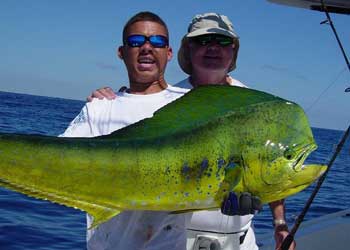 Dolphin (Mahi Mahi)
Dolphin (Mahi Mahi)
The schooling Dolphin fish can be found in deep offshore water close to the surface near floating objects such as buoys or drifts of floating sargassum weed. This fast swimming species lives only 5 years and is one of the fastest growing species thus have ferocious appetites. Dolphin's favorite food are flying fish and they also eat shrimp, squid, crustaceans or even baby dolphin fish. Live
Ballyhoo rigged on No.7 or No.8 steel wire with a 7/0 or 8/0 hook is a reliable bait. Chumming cut bait near weed lines or floating objects brings the larger members of the school close to your presentation. Many troll live Ballyhoo near floating weed patches. Image courtesy of Bouncers Dusky 33 - Miami Beach
DRUMS
 Drum, Black
Drum, Black
Black drum are often found on oyster bars, but also around rocks and wrecks in deep channels. Black Drums area large fish, usually growing to 40 to 60 inches and weighing as much as 50 to 100 pounds. Black Drum are bottom feeders that eat marine worms, shrimp, small crabs, small fish, crustaceans and mollusks, with a preference for blue crabs, shedder crabs, shrimp, oysters and squid. Generally, the fish enters estuaries to feed on a rising tide, and then leaves as the tide drops.
Image Courtesy of Southern Viking Charters - Naples

 Drum, Red (Redfish)
Drum, Red (Redfish)
Red Drums are primarily an inshore fish found throughout Florida and can reach 45 inches and weigh 51 pounds. Redfish feed in shallow waters in schools and feed on a variety of fish such as Atlantic Croaker, Pinfish, Mullet, Menhaden, Flounder and also crabs and shrimp. Redfish have many feeding patterns from hiding behind structure to ambush their prey, to sucking prey off the bottom which is where you hear the term Redfish tailing (look for the tails above the surface). It is common to find them around mangroves and oyster bars feeding on the small crabs and shrimp. Florida has specific bag limits for each region of the state so check current regulations before targeting this good eating species. Gigging, spearing, and snatching the Red Drum is prohibited.
If you come across a school of redfish tailing you are in for some fun! When Redfish are actively feeding they are easy to catch if you do it right. First, approach the tailing school very quietly then turn off your motor. Next cast very softly into the school and retrieve your bait quickly. Redfish spook easily so soft casting is the key.

Gulf Kingfish (Menticirrhus littoralis)
The Gulf kingfish is also widely known as Whiting or Gulf Whiting. This species is in the Drum family Sciaenidae. Commonly found on muddy shorelines in the surf, the Gulf kingfish is usually 12 inches but can grow to around 20 inches and is usually less than a pound. The record size is over 2 pounds. Easy to catch, the whiting is has a bland flavor but is good to eat when well seasoned.
 Filefish, Planehead
Filefish, Planehead
The Planehead Filefish is sometimes called foolfish, leatherjackets or shingles and grows to around 24 inches. The filefish can change shades according to their surroundings or other stimuli. This fish inhabits inshore seagrass beds and near shore reefs and feeds on a variety of foods from algae to crustaceans that it crushes with its incisor teeth. The filefish is good eating but only the unicorn filefish is legal to harvest for consumption.
For more information visit our Filefish page.
Photo courtesy of NOAA Photo Library - Image taken Gulf of Mexico
 Flounder, Gulf
Flounder, Gulf
The Gulf Flounder is the smallest of the Florida Flounder averaging 1 to 2 pounds but can be caught up to 6 pounds. One way to tell this Flounder from the other 2 found in Florida is by the very dark spots on it's back that form a large triangle.
Photo Courtesy of MBARA, picture taken off Mexico Beach
 Flounder, Southern
Flounder, Southern
The Southern Flounder is the 2nd largest of the Florida Flounder averaging 2 to 4 pounds, 15 to 20 inches in length but have been caught over 10 pounds.
 Flounder, Summer (Fluke)
Flounder, Summer (Fluke)
Florida's largest Flounder can be found in inshore coaster waters sitting on the bottom, preferring eelgrass beds and wharf pilings. When threatened they will bury themselves in the sand. They average 2 to 5 pounds but can get to 20 pounds and measure 17 to 25 inches long, but can grow to 30 inches. Since Flounder are bottom fish, so you need to get your chum down to the bottom to stimulate flounder feeding. Use squid strips or cut bait dropped into your chum slick. Flounder are excellent table fare and a little different to fillet. ![]() How to Fillet A Flounder
How to Fillet A Flounder
Courtesy of FWC - Caught March 31, 2012 Panama City
 Flying Fish (Exocoetidae)
Flying Fish (Exocoetidae) 
Flying fish are commonly found offshore in southern Florida especially in the Keys. This small fish has a unique set up pectoral fins that allow them to fly through the air to avoid predators.
Flying fish are estimated to be 25% of the dolphin fish diet. If you see a Sargassum weed line and flying fish soaring out of the water, you know dolphin fish are under the weeds. Flying fish are great as pitch bait for sight fishing Dolphin. Wahoo, tuna and swordfish also dine on flying fish. Flying fish also make great bait for kite fishing. Professional tournament anglers use flying fish as their secret weapon (we just gave away their secret!)
Groupers
Groupers are excellent table fare and can be found in all levels of the water column, commonly near structure. Groupers eat crustaceans, other fish, octopuses and young sea turtles. Grouper can be caught on fresh cut bait, such as mullet, mackerel or pinfish. They will also eat squid, octopus, and crabs. Live bait is by far the best bet. A live pinfish, a small gray or lane snapper, or a live cigar minnow are top draws for most grouper. Live cigar minnow, ballyhoo, pilchard and Spanish sardines also make great bait. These large fish require are very powerful and heavy requiring strong fishing gear. I have fished for large Grouper in deep water using a downrigger to bring the chum bag deep and attract this delicious fish. Be sure to identify the Grouper species you catch, some are endangered and illegal to catch.
 Grouper, Black (Mycteroperca bonaci)
Grouper, Black (Mycteroperca bonaci)
Black grouper feed on squid and fish. They are very large, usually 40 lbs. or more. They can be found on rocky bottoms, reefs, and drop off walls in water over 60 feet deep.
 |
 |
 |
 |
Grouper, Coney (Cephalopholis fulva)
The Coney is a small, colorful Grouper that is found in the warm waters of southern Florida, mostly the Atlantic coast, usually hiding in holes on coral reefs waiting to ambush it's prey. The Coney can be a variety of colors, all with spots, and they can quickly change colors between the bicolor phase to another phase. As you can see below, it the Coney has magnificent coloring!

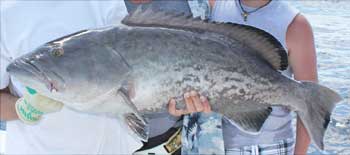 Grouper, Gag (Grey)
Grouper, Gag (Grey)
The Gag can be found on shallow reefs over rocks and reefs throughout Florida and they are usually caught around 25 pounds. When they get as big as in this picture caught off Fort Pierce their bellies turn black or a copper color and they are referred to as black bellies or copper bellies. On the Gulf coast it is less common to see Gag this large. The markings on their bodies can be described as "worm-like" and sometimes form kiss prints. Gag's are considered to most the best tasting of all the Groupers. Image Courtesy of Last Mango Sportfishing Charters, Fort Pierce
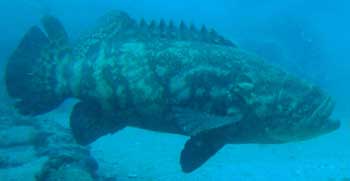 Grouper, Goliath (Jewfish)
Grouper, Goliath (Jewfish) 
The Goliath Grouper is an endangered species that has been making a come back. They are found on artificial and natural reefs at depths anywhere from 15 to 165 feet. This is a large Grouper weighing up to 800 pounds and can grow to 8 feet in length. Many anglers catch this giant while fishing for other species. The Goliath is known for stealing anglers catches as they reel them in. The Goliath feed on mostly slow moving creatures, rarely do they target large fish as the Goliath is a very lethargic species that spends most of it's time hiding out in caves waiting to ambush it's next meal. If you catch this fish, do not try to bring it aboard your boat, it is illegal in Florida. Image Courtesy of Florida Sea Grant:
 Grouper, Graysby
Grouper, Graysby
The Graysby likes to hide in holes and ambush it's prey. The Graysby grows to 15 pounds and is usually not targeted but an accidental catch.
Photo Courtesy of NOAA Photo Library
Grouper, Red Hind (Epinephelus guttatus)
The Red Hind are found on shallow reefs and feed on crabs, shrimp, lobster, some fish and octopus.
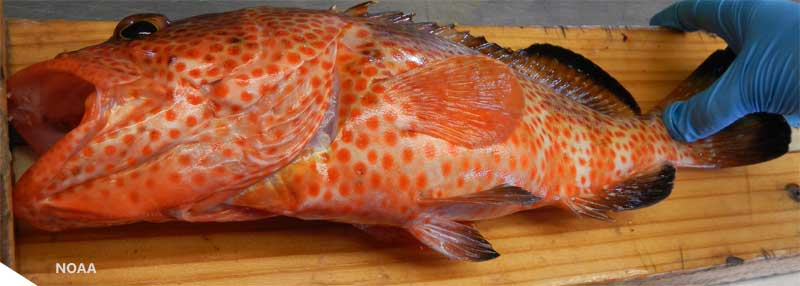
Grouper, Rock Hind (Epinephelus adscensionis
The Rock Hind is commonly caught at around 9 pounds on coral reefs and hard bottoms from the Gulf to the Bahamas. The Rock Hind feeds mainly on crabs and small fishes.
 |
 |
| Courtesy NOAA | Photo Courtesy of MBARA, picture taken off Mexico Beach |
 Grouper, Speckled Hind
Grouper, Speckled Hind
The Speckled Hind inhabits warm, moderately deep waters commonly between 180 and 350 feet. Speckled Hind usually engulf their prey whole, literally inhaling their food.
Beginning January 31, 2011 it is prohibition to harvest or retain the Speckled Hind and Warsaw Grouper in federal waters in the South Atlantic.
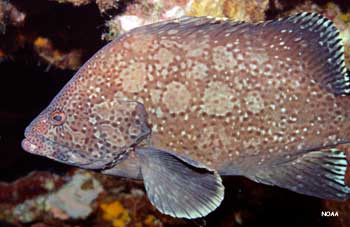 Grouper, Marbled
Grouper, Marbled
(Dermatolepis (Epinephelus) inermis)
The Marbled Grouper is classified as vulnerable by the American Fisheries Society and is rarely caught but can be found in most tropical waters. It is the different looking of the groupers with a heavy body and it's ability to change color. This rare fish is commonly caught at 15 pounds as an incidental catch while bottom fishing deeper reefs.
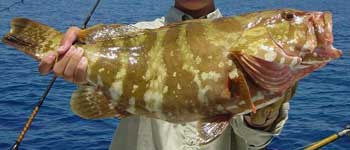 Grouper, Nassau
Grouper, Nassau 
The Nassau Grouper can be found in waters around 60 feet near coral reefs and structure, but has been found inshore and offshore in 300 feet. The species has been over fished and in 2016 was classified as "threatened". The Nassau Grouper is a slow-growing species reaching a little over 3 feet in length and can weight 55 pounds. It is a solitary fish, feeding in the daytime, mainly on other fish, and small crustaceans like crabs and small lobsters. This fish is very friendly and will swim right up to divers. Image courtesy Bouncers Dusky 33
You can tell a Nassau Grouper from a Red Grouper because a Nassau Grouper has a black saddle on the base of the tail. Unfortunately the man holding the Nassau above has a hand on the tail, hiding the black saddle. If you look close and you can see it.
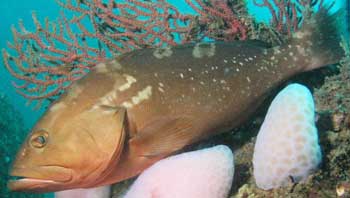 Grouper, Red
Grouper, Red
(Epinephelus morio)
Red Grouper like to hide in a hole and dart out to grab food and return to their hole. Due to this habit of darting out for food, they are opportunistic and will eat most anything. They prefer squid, crab, shrimp, lobster and octopus, but will eat any dead fish that sink into their habitat. Chumming with a weighted dispenser close to structure then dropping your line with bait into the chum slick works well for this species.


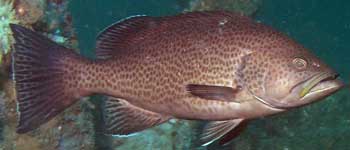
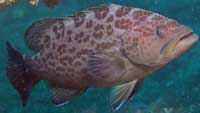 Grouper, Scamp
(Mycteroperca phenax)
Grouper, Scamp
(Mycteroperca phenax)
The Scamp is commonly 10 to 20 pounds and is sometimes found fairly close to shore, but generally sticks to deep reefs and ledges offshore. The Scamp's spots can sometimes form close together creating larger spot-like area's. The Scamp is plentiful in the Gulf of Mexico and can be found in the Atlantic mostly on the northern Florida coast. This Grouper is considered a prized catch among Groupers. Photo Courtesy of MBARA, picture taken off Mexico Beach on MB-124
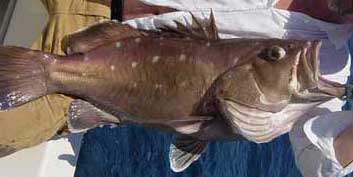 Grouper, Snowy
Grouper, Snowy
The Snowy Grouper is a mean one due to it's territorial nature. The Snowy can be caught inshore (usually the youngsters) but it is primarily found on the Atlantic continental shelf in deep water, 300 to 500 feet, along rocky edges and cliffs in swift currents. The Snowy Grouper can reach 70 pounds and 52 inches long. This species is in serious decline due to overfishing so the restrictions are 1 Snowy per person per day (always check current rules). The Snowy feeds on blue crab, fish, and squid.
Image courtesy Bouncers Dusky 33 - Miami Beach
Grouper, Tiger (Mycteroperca tigris)
The Tiger Grouper can be seen during the day prowling around shallow coral reefs from 5 to 20 feet looking for prey. This grouper has vertical stripes and sometimes a redish color; juveniles are yellowish. The Tiger reaches around 8-10 pounds, 35 inches long, and feeds on small fish, squid, shrimp, and crabs, devouring them with it's big teeth.
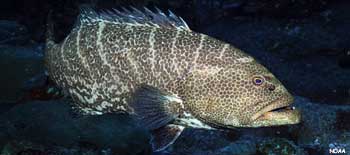 |
 |
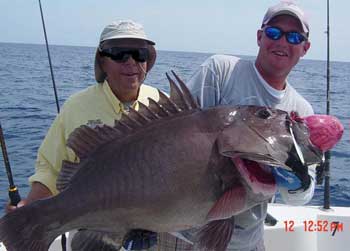 Grouper, Warsaw
Grouper, Warsaw
(Epinephelus nigritus)
The Warsaw Grouper is a large fish growing to 6 feet (1.8 m) and can weigh over 550 pounds (263 kg). Find the Warsaw near deep rocky ledges and sea mounts in 300 to 1000 feet (90-300 m) of water; the young are sometimes caught in inshore waters.
Beginning January 31, 2011 it is prohibition to harvest or retain the Speckled Hind and Warsaw Grouper in federal waters in the South Atlantic. Image courtesy Bouncers Dusky 33 - Miami Beach
Watch this video of a Warsaw Grouper eating an Amberjack below an oil rig on the Gulf of Mexico at 235 feet.
 Grouper, Yellowedge
Grouper, Yellowedge
(Epinephelus flavolimbatus)
The Yellowedge Grouper has been abundant in the Gulf of Mexico caught in deep offshore waters from 160 feet to almost 1,000 feet. Small live and cut baits can be used to catch this Grouper. This Grouper can grow to 30 pounds and tend to be smaller in the eastern Gulf of Mexico due to the lack of soft bottom. In the eastern Gulf the Yellowedge Grouper is most prevalent from Tampa to Charlotte in 600 feet of water near patch reefs with soft bottom areas where the Yellowedge can burrow in the soft sand. NOAA, Teachers at Sea, Photo courtesy of David Seay
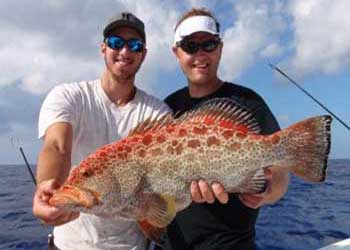 Grouper, Yellowfin
Grouper, Yellowfin
(Mycteroperca venenosa)
The beautiful Yellowfin Grouper is more commonly found in the warmer waters of the southern part of Florida on offshore coral reefs, wrecks and hard drop-offs.
The Yellowfin Grouper grows to 30 pounds and 4 feet long with the record of 34 pounds 6 ounces caught near Key Largo. Standard bottom fishing setup can be used to catch the Yellowfin with live bait or shrimp. Image courtesy of Bouncers Dusky 33 - Miami Beach
Grouper, Yellowmouth (Mycteroperca interstitialis )
 |
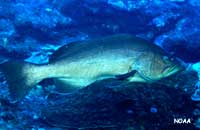 |
 |
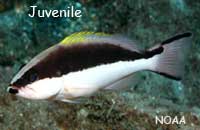 |
The Yellowmouth Grouper is a reef dweller that is very abundant in the Gulf of Mexico. The Yellowmouth is often confused with the Scamp and shares the same waters as the Scamp, but the Yellowmouth has a square tail. This fish pounces on jigs readily.
 Grunt, Blue Striped
Grunt, Blue Striped
Called Grunt because this fish's air bladder amplifies the sound made when it grinds it's teeth deep in it's throat, the Blue Striped Grunt resembles a Snapper but it is from another species family called Haemulidae. Found all over Florida from Mangroves out to coral reefs and wrecks, this bright yellow colored fish with glowing blue stripes travels in very large schools making a spectacular site when diving. This Grunt can be eaten like any other panfish but is not as good as a Snapper. en.wikipedia.org/wiki/File:Blue_Stripe_Grunt._Haemulon_sciurus.jpg
 Grunt, White (Key West)
Grunt, White (Key West)
White Grunts are in the Grunt family, but they are also called Key West Grunts, and mistakenly called White Snappers or Key West Snappers because they resemble Snappers. Commonly found offshore near rocks, ledges, or reefs. The adults form schools with other species of fish during the day over coral reefs or sandy bottoms. The White Grunt's average 17 inches and weights 5 pounds. White Grunts are nocturnal feeders, leaving offshore reefs at sunset in search for crustaceans, mollusks, echinoderms, and small fishes.Photo Courtesy of MBARA
 Herring, Blueback
Herring, Blueback 
The Blueback Herring is found in the St. Johns River in Florida and further northern waters. This Herring is used for bait and is caught with dip nets in shallow waters. This fish commonly found in brackish waters and overwinters in deep offshore waters. The Blueback can grow to 15 inches and weigh 3 lbs.
 Herring, Atlantic Threadfin
Herring, Atlantic Threadfin 
(Opisthonema oglinum)
The Threadfin Herring is also called Greenback and is a popular bait fish for Tarpon, Kingfish, Blacktip and Spinner Sharks, Jack Crevalle, Redfish and Snook. This fish can grow to 8 - 12 inches and is found in large schools inshore, near shore, and offshore. Catch the Threadfin with a heavy cast net or on hook n line. The Treadfin is tender and does not tolerate overcrowding in bait wells, see the video to the left. Use cut up Threadfin for chunk chumming or grind them up for an excellent chum. The Atlantic threadfin has been discovered in recent years to be an excellent eating fish. We have a full webpage on recorded catches in Florida and images of this fish. Most People do not know what the fish is when they catch it.

 Hogfish
Hogfish
The Hogfish can be found in many color variations around hard bottom areas, coral reefs, rocky ledges and shipwrecks all over Florida with most found in the western Keys and the Middle Grounds of the Gulf of Mexico. The Hogfish averages 3 pounds in the Keys and can be as large as 20 pounds offshore in 200 feet of water. There are fewer but larger ones the further north you go in Florida. Hogfish can be taken by hook and line using live Shrimp or Crabs as bait although the vast majority of Hogfish are taken by spear because it's hard to get a shrimp past the grunts! The Hogfish is excellent table fare, their diet of shellfish like Mollusks, Crabs, and Sea Urchins gives the meat a fine flavor. Photo Courtesy of Tyson Brown of New Port Richey, Florida
 Hogfish, Spotfin (Bodianus pulchellus)
Hogfish, Spotfin (Bodianus pulchellus)
The spotfin hogfish is also called the Cuban hogfish. This colorful species of wrass commonly inhabits reefs from 50 to 80 feet of water in the South Atlantic from the Carolinas to Brazil and in the Gulf of Mexico. The spotfin has been recorded in waters almost 400 feet deep, but this is rare. This is a small species that can reach lengths of 11 inches but is commonly found at 7 inches. The bright coloring of this species can be attributed to it's diet of crabs and shellfish. Photo submitted by Chuck D.
JACKS
 Amberjack, Greater
Amberjack, Greater
The Greater Amberjack is a big, strong fish that grow well over a hundred pounds and are primarily target for their quick fast action once hooked. They travel in schools and are commonly caught from bridges, piers, or docks as they travel by. Amberjack eat small fish especially bigeye scad, as well as crabs, squid, crustaceans, and invertebrates. Chumming for Amberjacks's should be made with herring, menhaden, mullet, pinfish and blue runners. Set out your chum slick and if Jacks are nearby you are guaranteed a fun time. Amberjacks are not commonly table fare but we have the secret to cooking this delicious fish on our webpage Grilled Amberjack.
 Amberjack, Lesser
Amberjack, Lesser
The lesser amberjack is the smallest amberjack, around 12 inches long and weighing 10 pounds, and seldom encountered by anglers because they are usually found in over 100 feet deep waters. Lesser Amberjack are believed to live deeper than other Amberjacks in water from 150 to 400 feet deep and spawn in offshore waters. Lesser Amberjack feed on fish and squid.
 Jack, Almaco
Jack, Almaco
The Almaco Jack typically is caught around 35 inches but can grow to over 60 inches and weigh up to 130 pounds. Normally found on deep water offshore wrecks, this species of Jack is not encountered as often as Amberjacks. The Almaco Jack feeds at all times of the day and night on bait fish and small Squid. The firm white flesh is excellent, similar to Tuna.

 Jack, Blue Runner
Jack, Blue Runner 
The blue runner is a spunky fish prized as an excellent bait fish because it survive long periods in the bait well and once on a hook can swim great distances. Blue runners are normally found at 12 inches but can grow to 28 inches and they are excellent table fare. Blue runners inhabit offshore waters in large schools and feed primarily on ?sh, shrimp, squid, and other invertebrates. Throw your cast net over a school, you'll have plenty for your next chum mix.Photo Courtesy of MBARA, picture taken off Mexico Beach
 Jack, Crevalle
Jack, Crevalle
The Crevalle Jack can be found both inshore and in deep offshore waters feeding on schools of bait fish, usually the cause of a bait fish frenzy as they coral the schools together for an easy dinner. The largest Crevalle ever caught in Florida was near Jupiter at 57 pounds.
Image Courtesy of Southern Viking Charters - Naples
 Jack, Horse-Eye
Jack, Horse-Eye
The Horse-Eye Jack can be found swimming in school, large and small, sometimes along with the Crevalle Jack. They inhabit mostly offshore reefs and wrecks but sometimes are found inshore. They have distinctly large eyes hence their name, a blue gray body with a yellow tail. This species of Jack can grow to 30 inches and weigh 8 pounds. The Horse-eye feeds on smaller fish, shrimp and crabs. Image courtesy of Bouncers Dusky 33 - Miami Beach

 Jack, Palometa
Jack, Palometa
(Trachinotus goodei)
Palometa jacks are commonly found in schools inshore in South Florida in clear surf at 1 to 2 pounds but can grow to 3 pounds and 20 inches long. This species of jack has 4 long bars at the top of its body, long dark colored fins and a light yellow breast. With a diet of small fish and crustaceans, this small fish is excellent table fare. Credit: Peter Pawlowski caught in the surf Hutchinson Island, Fort Pierce
 Jack, Rainbow Runner
Jack, Rainbow Runner 
The fast swimming, brightly colored rainbow runner inhabits both inshore and offshore waters. Highly migratory, the Rainbow travels in large schools feeding on small fish, shrimp and crabs. Reaching sexual maturity at 24 inches this runner in the jack species is a formidable opponent when hooked. Often hooked while trolling, this species is commonly used as trolling bait for billfish and tuna. Photo Courtesy of MBARA, picture taken off Mexico Beach

 Amberjack, Banded Rudderfish
Amberjack, Banded Rudderfish
The Banded Rudderfish is usually encountered less than 11 inches and under 10 pounds. It can be found both inshore and offshore, and is often found near floating objects. This fish feeds on fish and shrimp. Photo Courtesy of MBARA, picture taken off Mexico Beach on MB-124
 Ladyfish (Elops saurus)
Ladyfish (Elops saurus) 
Ladyfish can be found in great numbers in bays, lurking just outside of dock lights at night, feeding on bait fish and shrimp. They are fun and easy to catch and make fantastic chum or chunk chum. Use cut up Ladyfish to catch Snook, Grouper, Shark, and other species that like chunk bait. Photo submitted by Leonardo Manella
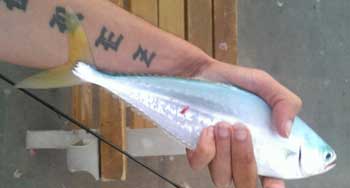 Leatherjacket
Leatherjacket 
Leatherjacket are found inshore, usually near beaches and the shallow waters of the Gulf of Mexico and southern Atlantic coast. Growing to12 inches in length, the Leatherjack eats small fish and shrimp. Jorge P. caught this leatherjacket on Sunny Isles Beach in February.
 Lionfish (Pterois miles and P. volitans)
Lionfish (Pterois miles and P. volitans) 
Lionfish are an invasive species that inhabits all coastal waters of Florida. This species has no predators and can destroy delicate marine environments if left unchecked. Lionfish are excellent ambush hunters, with lightning speed they capture their prey. They are voracious and can wipe out up to 95% of native fish on a reef if left unchecked! They use their venemous spines to deter predators, and as of this writing there are no known fish that prey on Lionfish in the Tropical Western Atlantic. FWC encourages anglers and divers to eradicate any lionfish you encounter. The best way to destroy this fish is to use a speargun or gaff. Lionfish have venomous spines so be very careful when you encounter this creature. The lionfish flesh is very good to eat and the only precaution during preparation is to cut off the venomous spines, then prepare the fish as you would any other. Check out our Lionfish page for more details. Courtesy of NOAA
LOBSTERS see section below
 Lookdown
Lookdown
Lookdown's are most often found in small schools near the coast in shallow waters over sandy bottoms, usually near bridges, pilings and on coastal shipwrecks. Lookdowns are in the Jack family and can grow to 19 inches and up to 3 pounds. Lookdowns feed on small worms, small fishes and crustaceans attached to structures. The Lookdown puts up a great fight but has little food value so please release this beautiful fish.
Source:http://en.wikipedia.org/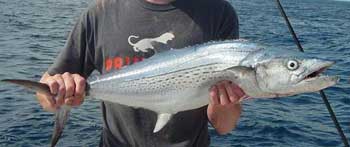 Mackerel, Cero
Mackerel, Cero
The Cero Mackerel is usually caught at 10 pounds but can get to 30 pounds. The Cero is a tropical Mackerel species rarely found further north than Palm Beach. The Cero can be identified by it's long lateral stripe. Feeding on small fish and squid this fish can be found on offshore reefs and wrecks and sometimes inshore. Image courtesy of Bouncers Dusky 33 - Miami Beach
 Mackerel, Chum (Scomberus japonicus)
Mackerel, Chum (Scomberus japonicus) 
This mackerel species is primarilary found on the Atlantic side of the state and into the Keys, mostly on the coast, although it has been found in the Gulf of Mexico, mostly on the western side.
 Mackerel, King (Southern Kingfish)
Mackerel, King (Southern Kingfish)
King Mackerel travel in large schools near the surface of the water, close to shore over sandy bottoms. King Mackerels can also be found near reefs, wrecks and other hard structures. Bottom fishing from bridges, piers, the surf and from boats is the best way to catch a Kingfish. Downriggers are often used to get the chum below the surface to entice this powerful fish. King Mackerel are heavy feeders preferring herring, shad, sardine, pilchard, menhaden, jack, anchovy, ladyfish, mullet, drum, and will also eat shrimp, sand fleas and squid. Image courtesy of Last Mango Sportfishing Charters - Fort Pierce
![]()
The Spanish Mackerel is not the only Mackerel with yellow spots - young King Mackerel have the same spots. Anglers frequently confuse juvenile Kingfish for Spanish, bringing in under-sized Kings during tournaments, says Carol Cox of MBARA. 
The easiest way to tell them apart is by the distinctive "black flag" on the dorsal fin of the Spanish.
Captain Charlene Burke of About Fun Charters showing off the "black flag" on the dorsal of a Spanish Mackerel.
 Mackerel, Spanish
Mackerel, Spanish 
The Spanish Mackerel is a very colorful fish. The Spanish can be found close to shore and further out in waters to about 40 feet, traveling in schools. This fish migrates seasonally, spending the winters in southern Florida waters then migrating north to spawn and spend the summers in the Panhandle or the Carolina's on the east coast. The fish is targeted primarily for later use as bait for larger species, but it's strong white flesh is quite good and is used for sushi by many. Spanish Mackerel are aggressive feeders preferring shrimp, squid and small fish. The trick to catching a Spanish Mackerel is to use fast moving lures such as spoons or by trolling.
 Margate
Margate
The Margate, either White or Black, belongs to the grunt family. The Margate can be found on offshore reefs, inshore, or the surf, and grows to around 15 pounds and 2 feet. This fish is referred to as the white snapper and makes great table fare because it feeds on crustaceans, although you do not get a lot of meat off the fish. Source: NOAA
 Marlin, Blue
Marlin, Blue
Blue Marlin primarily feed near the surface on a diet of tuna, mackerel, squid, octopus and any number of fish species indigenous to the environment.
 Marlin, White
Marlin, White
White Marlin can be found in very deep water, usually 300 to 500 feet down. Downriggers with chum bags attached or weighted dispensers must be used. They usually eat fish such as herring, jacks, mackerels, triggerfish, dolphin fish and flying fish, but a significant portion of their diet is squid and crabs.
Sam sent us this great catch 9/20/2016.
Marlin, Black
The Black Marlin is found in Pacific waters on the surface near shore close to land masses, islands and coral reefs. This marlin is one of the fastest fish on earth reaching speeds up to 80 mph and weights up to 1,700 lbs. The black marlin feeds on dolphinfish, squid, cuttlefishes, octopods, mackerels, trevallies, swordfish, and large decapod crustaceans, but prefers small tunas.
Billfish ID
 Menhaden Fish
Menhaden Fish 
The Menhaden Fish is an important bait fish found on both the Atlantic and the Gulf of Mexico, and they are two different species. This fish can be found in huge schools and is caught with cast nets. The Menhaden is used to make Menhaden oil and Menhaden Milk that is used for chumming fish, either straight using a dripper unit or mixed in with your favorite chum recipe. Many charter boats make a not so secret potion by adding Menhaden Oil to store bought chum blocks. Visit our Menhaden fish page for information on this very important species.
Minnow, Glass (Silverside or Anchovy) 
Glass minnows are sometimes called Silversides or Anchovy and are a popular bait fish from Maine through the Gulf of Mexico. This fish seldom reaches over 3 to 4 inches and is abundant in large schools along the shore in seagrass beds and on offshore reefs. This bait fish is an important food source for predatory fish that will dart through the Glass Minnow's large schools feeding.
 Mojarra, Slender
Mojarra, Slender 
Mojorra are common bait fish found on both coasts of Florida in schools, mostly inshore. The Slender Majorra is a small fish commonly found at 3 inches. Photo Courtesy of MBARA, picture taken off Mexico Beach
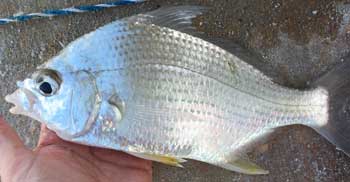
Mojarra, Silver Jenny (Eucinostomus gula)
The Silver Jenny mojarra has an unusual looking mouth which helps to identify this species. The mouth looks like a mouth inside a mouth! It is found in schools inshore preferring bays with muddy bottoms and high salinity. Jenny can grow to 9 inches but is commonly caught at 6 inches.
Visit our Mojarra page for more information on this species.
Mojarra, Spotfin 
The Mojarra Spotfin is usually 3 inches but can grow to 8 inches. This schooling bait fish lives inshore in many oceans in both warm and cool waters. The prefer open, shallow waters that have sand and mud bottoms, seagrass, and mangroves. They are abundant in tropical estuaries and are used for Snapper bait.
 Mullet, Black Striped
Mullet, Black Striped 
Mullet are common table fare and are used as bait for larger sport fish. Mullet range from 8 to 12 inches in length and can be found in large schools in inshore coastal regions such as bays, estuaries and freshwater environments. They feed on algae, small crustaceans, and detritus. They can be caught with a cast net and used as bait or for making chum. Photo Courtesy of MBARA, picture taken off Mexico Beach
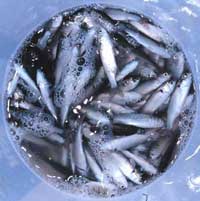 Mullet, Silver
Mullet, Silver 
The Silver Mullet are mostly used for bait due to their small size, less than 12 inches. They live in large schools and are caught with cast nets for bait or to use for chumming.
Courtesy of NOAA Photo Library Image taken Gulf of Mexico
 Needlefish, Atlantic
Needlefish, Atlantic
The shinny Atlantic Needlefish is very common and can be found inshore hovering around pilings. Courtesy of NOAA Photo Library - Image taken Gulf of Mexico
 Needlefish, Spotted Hound
Needlefish, Spotted Hound
Needlefish hover just below the surface in schools over shallow reefs or in the quiet waters of estuaries hunting small fish. There are many species of Needlefish in Florida, most averaging about a foot. It is not uncommon to see smaller specimens inshore around docks and mangroves. Watch out, this fish can jump out of the water and have been known to get aggressive and spear you if agitated. The larger species like the Hound or Flat Needlefish can be found over inshore reefs in loose schools. This fish has very good meat but is shunned by most because the flesh is a green color. The Spotted Hound Needlefish shown here was caught in Key West on an inshore reef and is rare at 48". Normally in the Keys they are seen at 18 to 24 inches both inshore and in the backwaters. Use caution if snorkeling near one of these, they have been know to attack snorkelers. This Hound Needlefish caught in Key West by Absolut Fishing Charters.
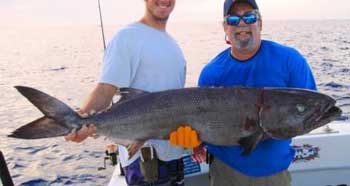 Oilfish
Oilfish
The 60 to 100 pound Oilfish travels in schools and is caught unintentionally by anglers fishing for Tuna and Swordfish in the deep, open waters near the continental shelf. This very oily fish is edible and quite good since it feeds on fish, squid and crustaceans but some have complained of stomach irritations as the oil is not easily digested. Image courtesy of Bouncers Dusky 33 - Miami Beach
 Perch, Sand
Perch, Sand 
The Sand Perch is common on both coasts of Florida and this colorful fish reaches around 8 inches. Sand Perch are found from bays and shorelines to well offshore over a variety of bottoms. They seem to prefer open bottom with patches of grass or scattered rock, and also like deep channels. This small fish is tasty but mostly used as bait for Tarpon or Grouper.
Photo Courtesy of MBARA, picture taken off Mexico Beach
 Perch, American Silver (Bairdiella chrysoura)
Perch, American Silver (Bairdiella chrysoura)
The American Silver Perch can be found from New York to Florida in muddy inshore waters in bays and estuaries and lurk in seagrass beds. Silver Perch grow to 12 inches and are similar in appearance to the Sand Seatrout with a silvery skin and yellow fins. This Perch eats crustaceans and small fish which attributes to it being excellent tablefare.

The picture above was caught in Riviera Beach under a bridge. The other picture of a Silver Perch next to my 5 gallon bucket wascaught at Phill Foster Park in Singer Island Florida. -- Nov 7, 2017 by Frances E. holding her catch.

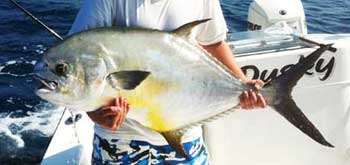 Permit (Trachinotus falcatus)
Permit (Trachinotus falcatus)
Permit are usually found in shallow, tropical waters such as flats, channels, and muddy bottoms feeding on crabs, shrimp, and smaller fish. Permit are commonly found from 20 to 30 pounds with the record in Florida at 51 pounds. Angler fish for Permit by stalking them by sight on shallow flats, and cast directly to them. Use fresh crushed crab and lobster in a dispenser for an excellent attractant for the Permit fish; use small live crab on your hook.
On offshore wrecks large Permit swim around the wrecks and sometime hang around the bottom of the structure. If you hook up a Permit near structure it is best to unhook from your anchorage and drift to bring in your catch. This species tends to dive for cover once hooked and if they get into the structure you will soon lose your prey. Live crab is by far the best bait for Permit; use a splitshot to weigh the crab down if the fish are lower in the water column. Permit have excellent eyesight so use dark colored hooks and will don't use swivels. Image courtesy of Bouncers Dusky 33 - Miami Beach
 Pigfish
Pigfish 
The Pigfish inhabits bays and muddy coastal waters in northern and southern coastal waters. They can grow to 15 inches, but are most commonly caught at 6 inches. Pigfish feed at night using their throat teeth to grind up shellfish and small bits of other food. The Pigfish is great eating, but is mostly used for bait fish. Tarpon love Pigfish. Photo Courtesy of MBARA, picture taken off Mexico Beach
 Pilchards
Pilchards 
Pilchards are small bait fish in the herring family that are easily caught with a cast net because they travel in large schools. Pilchards must be kept in an uncrowded, well aerated tank with constant water changes, they do not keep as well as other bait fish like pinfish but do make great bait.
 Pinfish
Pinfish 
The Pinfish is a small bait fish growing to 8 inches that can be found inshore in schools numbering in the thousands. They are found in bays and shallow water grass beds where they feed on shellfish. Use a castnet, Sabiki Rig or Pinfish trap to collect Pinfish for bait. They are very hardy and survive nicely in a bait well.
 Pinfish, Spottail
Pinfish, Spottail 
The Spot Tail Pinfish is a bait fish found in shallow coastal waters and in lower areas of coastal bays in grass beds but can also be found offshore around hard bottoms and reefs from Chesapeake Bay all the way into the Gulf of Mexico. This fish can be found in small schools, grows to 10 inches and is usually caught with small baited hooks. Us this fish as bait or cut up for chunk baiting. Photo Courtesy of MBARA, picture taken off Mexico Beach
 Pomfret, Big-Scale
Pomfret, Big-Scale
The Big-Scale Pomfret (Taractichthys longipinnis) is a rarely caught fish because they live in depths over 1,500 feet in the Atlantic Ocean along the continental shelf. Mostly solitary, the Pomfret can sometimes be found in loose schools. This deep bodied fish grows up to 3 feet long with the world record at 20 pounds 10 ounces caught in St. Augustine. The Big-Scale Pomfret feeds on shrimp and squid.
This Pomfret is usually caught as by catch with little know about them. As of May 2012 there is no mention of fishing regulations on SAMFC. Image courtesy of Bouncers Dusky 33 - Miami Beach
 Pompano, African
Pompano, African
The African Pompano is also know as Pennant-Fish and Threadfin Trevally, Cuban Jack, Atlantic Threadfin, Pennantfish, Threadfin Mirrorfish, and Trevally. Adults travel solitary in tropical waters both inshore and offshore in the first 200 feet of the water column, sometimes 300 feet deep, generally swimming deep over sandy bottoms, adjacent to rocky structure. The juvenile African Pompano has long, filamentous dorsal and anal fin tips said to deter creditors. The African grows to a length of 5 feet but are normally in the 18 to 24 inch range and it can grow to 50 pounds with 20 to 30 pounds common in Florida. African Pompano feeds on slow-moving crustaceans, small crabs, and occasionally on small fish. This fish is a great fighter and excellent table fare. The above image is a 40 lb African Pompano.Image courtesy of Bouncers Dusky 33 - Miami Beach
 Pompano, Florida
Pompano, Florida
Pompano are a highly prized food fish and sought after game fish that is usually between 6 and 10 inches long. This is a schooling fish and is a good pier and shore fishing target. Often confused with the Permit which is deeper bodied, Pompano rarely grow larger than 6 pounds, Permit are common to 40 pounds. They feed on mollusks, crustaceans, and sand fleas.
 Porgy, Grass
Porgy, Grass
As its name implies, the Grass porgy can be found on both coasts of Florida inshore in shallow water on grass beds and sandy bottoms. Usually solitary, they can sometimes be found in small schools. This is a small porgy growing to a pound and 10 inches long. Delicious to eat because this species feeds on invertebrates including crabs, clams, snails, worms and starfish. Catch a this porgy using live or dead shrimp or squid. Pictures submitted by Maureen Jan 2015. They caught about 30 fishing inshore near an island off Ozona on the Gulf of Mexico.
 Porgy, Jolthead
Porgy, Jolthead
The Jolthead Porgy can be found offshore around rocky reefs, debris, and wrecks, typically in 30-180 feet of water. The Jolthead is distinguished with a blue line under it's eyes and orange around it's mouth. This Porgy feeds on Mollusks and Crustaceans. 
The Jolthead can be caught on dead bait (Spanish sardines, threadfin, finger mullet) squid, and crustaceans. This fish ranges from 2 to 10 pounds and are good tablefare.
The Jolthead to the right is about 12 inches and was caught on the Gulf of Mexico in 100+ feet on a wreck and is in a cooler full of Yellowtail Snappers. Courtesy of Bouncers Dusky 33 Miami Beach
 Porgy, Littlehead
Porgy, Littlehead
The most brightly colored of the Porgy's, the Littlehead Porgy has small silver scales with violet color spots on the scales that form stripes. This Porgy is only found in the tropical Atlantic, northern Gulf to the Caribbean usually at 15 inches in length. This Porgy is a good tasting fish which feeds mostly in invertibrates
.Photo Courtesy of MBARA, picture taken off Mexico Beach on MB-124
 Porgy, Red (Seabream)
Porgy, Red (Seabream)
The Red Porgy is an uncommon catch due to it's reduced populations from earlier overfishing. The Red Porgy is sometimes called Seabream and is found is waters from 60 feet in depth to the edge of the continental shelf where they can be 16 inches and weigh 2 pounds. The Red Porgy are bottom feeders who use their strong teeth to prey on snails, crabs and sea urchins from structures and they also consume worms and small fishes. The Red Porgy in this picture was caught off Naples during the winter in 125 of water on a wreck while bottom fishing.
 Porgy, Saucereye (Calamus calamus)
Porgy, Saucereye (Calamus calamus)
The Saucereye Porgy ranges from 11 inches to 22 inches and weighs from 1 1/2 to 3 pounds. Common on reefs around Key West, this porgy feeds on a variety of creatures including sea urchins, brittle stars, mollusks, sea worms, hermit crabs, and crabs.
Photo Courtesy of MBARA

Porgy, Sheepshead
Sheepshead porgy has a small dark spot at the base of the pectoral fin, and there is often a maroon-colored margin on the tail. Sometimes the fish will display dark bands so that it resembles a sheepshead, which is where it gets its name.
Photo Courtesy of MBARA
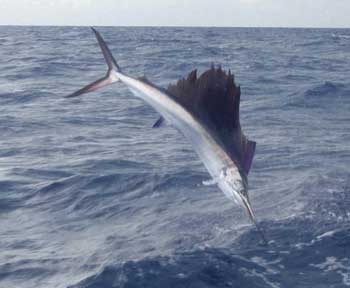 Sailfish, Atlantic
Sailfish, Atlantic
Atlantic sailfish can be found near schools of bait fish in areas where there is a temperature changes. They feed on mackerel, tuna, herring, ballyhoo, needlefish and mullet. They can be found near the Gulf Stream in deep water near underwater structures like rock walls and drop offs. The best bait is live ballyhoo and pilchards. Sailfish show up in Southeast Florida and the Keys in Mid-October, offering anglers great fall action.
Image courtesy of Bouncers Dusky 33 - Miami Beach
See Billfish ID above
 Sardine, Spanish
Sardine, Spanish 
Sardines travel in large schools close to shore and are popular around the world for food, bait, and as additives to other products such as fertilizer. They are caught mainly at night, when they approach the surface to feed on plankton. To catch sardines it is best to use a castnet and you will catch hundreds if not thousands in one cast. To use Sardines as bait first twist the center of the body to open up the fish, this allows other small fish to come and nibble on the sardine and attract the larger fish to the commotion. Hook the sardine though the eyes or up through the head from the the mouth so the hook is exposed. For catching large fish use a double hook system. In Florida, Spanish Sardine is purchased frozen, the fish in this picture is from such a box.
 Sardine, Scaled
Sardine, Scaled 
The Scaled Sardine is sometimes call Whitebait and is a common bait fish found in southern tropical waters. The Scaled Sardine can be caught easily with bait net, just chum the water and when they arrive cast away. Do not over crowd them in your bait well as they are sensitive to water quality. Growing to about 6 inches this fish is excellent bait and makes great chum.
 Sawfish, Smalltooth
Sawfish, Smalltooth
This critically endangered species is characterized by a long, toothy nose extension snout and can be found as large as 23 feet long. Sawfish live only in shallow, muddy water and can be found in both freshwater and saltwater in tropical and subtropical regions. They inhabit coastal areas such as bays and estuaries, but frequently penetrate far into rivers and major lakes. Capturing sawfish is illegal in the USA and Australia.
Image Courtesy of NOAA
 Scad, Round (Cigar Minnow)
Scad, Round (Cigar Minnow) 
The Round Scad is a commonly called the Cigar Minnow. This common bait fish can grow to 12 inches and can be found in shallow waters on the bottom or mid-water. Grouper and Snapper love this fish so use them as bait, for chunk chumming or ground up for an appealing chum mix.Photo Courtesy of MBARA

 Sea Bass, Black
Sea Bass, Black 
Black Sea Bass average 12 inches and weigh 1 pound and are bottom-feeders that love crustaceans such as crabs and shrimp, as well as small fish, worms and mollusks. Good chum & bait are squid, clams and small bait fish is best and should be presented near the bottom around rock jetties and pilings, reefs and wrecks. Photo Courtesy of MBARA, picture taken off Mexico Beach

 Sea Bass, Bank
Sea Bass, Bank
Bank Sea Bass are found in deep, offshore waters from 50 to 500 feet around rocks and reefs with high relief. The Bank Sea Bass forages along the bottom on small fish, squid and crustaceans. This beautifully colored Bass is small, it only reaching 11 inches in length.
Photo Courtesy of MBARA, picture taken off Mexico Beach
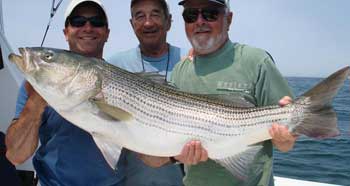 Sea Bass, Stripers or Striped (Rockfish)
Sea Bass, Stripers or Striped (Rockfish)
Striped Bass is a schooling species rarely found more than several miles from the shoreline. Anglers usually catch stripers in river mouths, in small, shallow bays and estuaries, and along rocky shorelines and sandy beaches. Striped bass usually grow to approximately 20 inches and weigh about 30 pounds, but can be as long as 6 feet and weigh as much as 125 pounds. Striped bass are voracious predators of a variety of small fish and invertebrates, including worms, squids, menhaden, anchovies and crustaceans.
The most effective way to chum for Stripers or Striped Bass is to chunk chum with live bait of their preferred species such as herring, menhaden, flounder, alewives, sand lance, silver hake, tomcod, smelt, silversides, and eels. They also consume significant quantities of lobsters, clams, small mussels, sea worms, squid, eels, and soft crabs, which you can also use for your chum mix. They feed mostly at dusk and dawn, thus the best time to fish for stripers. Anglers looking for trophy size Stripers use live eels, so make your chum mix with eels and catch a big one! Freshwater Sstripers feed almost exclusively on large shad and minnow species, so make your chum with these species.
Another popular method of catching a Striped Bass around the waters of Long Island is Clam Chumming. Soft-shell (steamer) clams are also a favorite chum in the Chesapeake Bay area. Although Stripers by design cannot get the clams out of the shells, they go crazy for them when offered and this can provide for some fast, furious action! Image courtesy of Bouncers Dusky 33 - Miami Beach
 Seatrout, Sand
Seatrout, Sand
The Sand Sea Trout is a silver colored fish lacking any markings and are found in shallower bays and estuaries with oyster beds and seagrass bed. They can be from 19 to 25 inches and weigh 2 to 3 pounds. When they are located near passes in estuaries they eat mainly fish, especially bay anchovies and gulf menhaden. Sea Trout feed on squid, peeler crabs, shrimp, live spot or other live bait, so a chum mix of their favorite food is best. Sand Sea Trout are best eaten fresh, they do not freeze well.
 Seatrout, Silver
Seatrout, Silver 
The Silver seatrout is similar to the Sand seatrout but smaller, averaging 10 to 13 inches and is a great bait fish for large game fish such as King Mackerel and Barracuda. Find the Silver Trout close to shore near muddy or sandy bottoms, usually in the winter in the northern Gulf of Mexico in bayous and the intercoastal waterway. They can be caught with a cast net or small baited hooks. Use them cut up for bottom fishing reefs or inshore and they make great chum.
 Seatrout, Speckled (Spotted)
Seatrout, Speckled (Spotted)
Speckled seatrout inshore action in the winter months throughout the state is a lot of fun with the average sized catch at 4 pounds. Look for the spotted seatrout in grassy areas, around structure, in the mangroves or in deep holes with a sandy bottom. Speckled seatrout feed on crustaceans, shrimp, crabs and bait fish. Free line live pinfish or shrimp near the edges of mangroves or over grass beds to attract them out of deep holes. This species is fun to catch and quite tasty, best eaten fresh, not frozen.
 Seatrout, Weakfish
Seatrout, Weakfish
The schooling Weakfish is the most common of the Seatrout and usually are found at 12 to 18 inches, but can grow to 3 feet and weigh 19 pounds. They have the same diet and habitat as the other Seatrout. Be careful when reeling in a weakfish it gets it's name from having a weak mouth, hooks tear apart their mouths.
Diane M. caught this Weakfish in 80 feet of water off Ponce Inlet on Live Shrimp while bottom fishing.
 Shad, American
Shad, American
The American Shad is a schooling fish found in very deep coastal waters, sometimes almost a mile down and grow to about 20 inches, but can be up to 30 inches and weigh up to 12 pounds. They come ashore to freshwater inlets and rivers to spawn. The American Shad is primarily a plankton feeder, but will eat small shrimp and fish eggs.
 Shad, Alabama
Shad, Alabama 
The Alabama Shad is also a schooling fish that grows to 12 to 18 inch. This species has declined largely because of the many locks and dams blocking access to spawning areas. The Alabama Shad was listed as a Species of Concern in 1997 and fishing is prohibited.
Shad, Hickory
Like other Shad, the Hickory Shad is a schooling fish adults living in coastal ocean waters from Maine to Florida. The Hickory Shad feed on small fishes, fish eggs, crabs and other crustaceans, and squid. At 12 to 20 inches, the Hickory Shad are noticeably smaller than American Shad.
SHARKS see Sharks page
 Sheepshead
Sheepshead
Look for Sheepshead near structures that have oysters growing on them such as mangrove roots, jetty rocks, docks, pilings, and piers. Sheepshead are common at 4 pounds but can be found further from the shore near navigational markers at 10 pounds or more.
Chum made with oysters, shrimp, clams, clam juice, scallop guts, sand fleas, or fiddler crabs are best for Sheepshead as these crustaceans are their main diet. Ever notice they have teeth like humans and they can crush oyster shells with ease.
SHRIMP see section below
 Skate, Clearnosed
Skate, Clearnosed
The Clearnosed Skate is a Florida native found mostly inshore in salt and brackish waters. This Skate can be found at 1 1/2 to 3 feet long and does not possess a stinger like Stingrays. They are usually not targeted as sportfish but this fish will take any bait if in their range. The Clearnosed Skate feeds on crustaceans, mollusks, sand fleas and fiddler crabs giving them excellent tasting flesh. Prepare Skate utilizing the wings and use in any recipe calling for Scallops as they have a very similar flavor. You  can also use Skates for bait, Sharks love them. Photo Courtesy of MBARA, picture taken off Mexico Beach
can also use Skates for bait, Sharks love them. Photo Courtesy of MBARA, picture taken off Mexico Beach
 Slippery Dick (Halichoeres bivittatus)
Slippery Dick (Halichoeres bivittatus)
This small fish in the wrasse family found in tripical waters on both coasts can reach up to 14 inches. Find the Slippery Dick on reefs and grass beds inshore up to 50 feet deep feeding on invertebrates including crabs, shrimp and sea urchins. This species goes through many color changes as it grows and all start out their lives as females. The Slippery Dick is very good to eat, that is if you find one large enough. The Slippery Dick makes excellent bait for bigger species like Snook.
Snappers
 Snapper, Blackfin (Lutjanus buccanella)
Snapper, Blackfin (Lutjanus buccanella)
The Blackfin Snapper is a deepwater fish usually found in over 600 feet of water, but your fish are found in a little as 100 feet of water. The fish is stocky but small, only growing to 16 inches and 4 pounds. Find this fish near deep drop offs near continental shelf. Chumming for this deep water fish is not possible, but how about trying a line bait dispenser attached above your live or cut bait presentation.
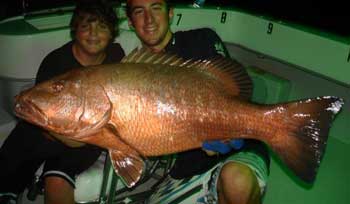 Snapper, Cubera
Snapper, Cubera
The Cubera Snapper can reach 150 pounds and has the nickname The Bad Boy because it has two large canine teeth capable of grabbing large prey or easily crushing whole lobsters. Find the Cubera on reef and wrecks using live baits. If you want to catch a big one put a Spiney Lobster on a heavy jig with strong line and drop down to a reef; be sure to hold on tight, this big fish will dart for cover and give you one exciting fight. The Cubera is suspect of having Ciguatera, so testing with a portable kit for the presence of the toxin is advisable.Image courtesy Bouncers Dusky 33 - Miami Beach
 Snapper, Dog (Lutjanus jocu)
Snapper, Dog (Lutjanus jocu)
The dog snapper is also one of The Bad Boys (see cubera above) with two large canine teeth and all the same traits of the Cubera, it's cousin, but only gets to 20 pounds and average 24 inches. Record size specimens have been recordered at over 60 pounds and 50 inches. The Dog snapper is not picky and will go after any kind of bait or jig. They are usually solitary and found around shallow reefs in the Keys and Caribbean. To distinguish the dog snapper, look for a pale triangle and a light blue interrupted line below the eyes.
 Snapper, Lane
Snapper, Lane
The lane snapper has bright yellow lines running it's length with a red tail. The lane are more common in south Florida with the young found inshore and in the mangroves and the adults on inshore reefs. The largest lane snapper caught near Pensacola was 6 pounds 6 ounces; anglers can expect an average of 12 inches on offshore wrecks and reefs. The lane snapper is a bottom feeder preferring crustaceans, mollusks, and fish.
 Snapper, Mahogany
Snapper, Mahogany
The Mahogany Snapper is rare and usually found in the Bahamas and Caribbean, but sometimes in the Keys and South Florida. They like very salty water that is shallow. The Mahogany has big eyes, grows to 20 inches, and usually swims in schools around reefs.
 Snapper, Mangrove (Gray)
Snapper, Mangrove (Gray)
Mangrove Snapper are common in shallow waters especially around mangroves but larger Snappers move off shore to hard-bottom or reef areas for more food and shelter. Usually found at 10 inches inshore, they can grow to 2 feet offshore. Mangroves are inquisitive fish that will come out of their ambush spot to see what's going on when they hear noise like your engines motor, but they will flee after hearing loud sudden noises. These fish are considered extremely smart and once you have hooked one, the rest become tight lipped after seeing your hook. Toss in their favorite baits?lively Pinfish and big, live Shrimp to chunk chum or make your chum from Shrimp and chumming at night is necessary.
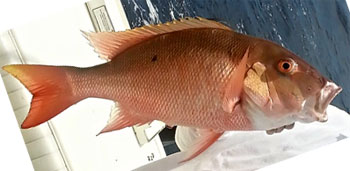 Snapper, Mutton
Snapper, Mutton
Mutton's normally inhabit deeper water, shallower patch reefs and wrecks, as well as channels and creeks. Larger Mutton can be found travelling grass flats following stingrays. Where there is an abundance of small Pilchards, Ballyhoo, and Herring you will find the Mutton Snapper. Using live Pilchards to chum for these fish is a great tactic. Sardines can be cast netted and Pinfish trapped for line bait or live chumming.
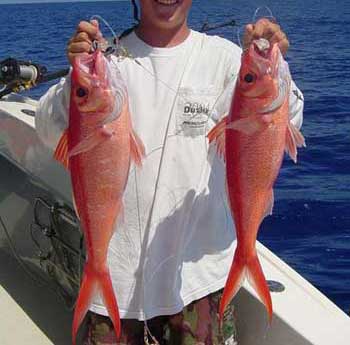 Snapper, Queen
Snapper, Queen
The Queen Snapper is a rare catch and a unique snapper having a long, slender body with big forked tail with yellow eyes. The Queen snapper grows to 3 feet long and can be found in very deep water, 600 feet or more. The Queen can be found amongst very large rocks, so you cannot anchor and target this species; dropping your line deep and drifting by rocks is the only way you can hopefully catch this great eating fish. Image courtesy Bouncers Dusky 33 - Miami Beach

Lui caught this magnificent Queen snapper off Marathon in 650 feet of water aboard BITIT on December 9, 2012. He used for bait a fresh piece of Blackfin tuna that he caught minutes before.
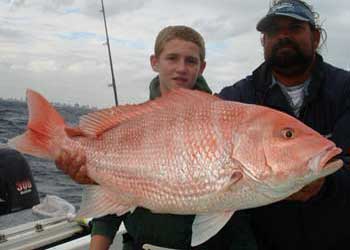 Snapper, Red
Snapper, Red
Red Snapper can live 25 years and weight more than 25 pounds with the record in Florida caught at 46 pounds near Destin. This Snapper is more abundant in the colder northern Florida offshore deep wrecks and reefs but can be found statewide.
The Red Snapper feed on crab, shrimp, fish and worms. Chumming with crushed blue crab or mussels can drive the Red Snapper into a frenzy. There are federal and state fishing restrictions on this species so be sure to know the current rules before taking very tasty this fish home for dinner.
Image courtesy of Bouncers Dusky 33 - Miami Beach
 Snapper, Schoolmaster
Snapper, Schoolmaster
The Schoolmaster Snapper is a small yellow and brown colored Snapper that is usually found in shallow waters (8 feet or less) in small schools near reefs. This fish is a great kid's catch as they are easily caught during the day and take most baits.
Photo Courtesy of MBARA - Note this species not found in NW Gulf
 Snapper, Silk
Snapper, Silk
Silk Snapper are the most common deepwater species and is often found for sale in fish markets. Silkies can be found in water from 300 to 700 feet deep near rocks and pinnacles and average 8 pounds. The best bait is squid, blue runner, or chunks of tuna on circle hooks that you drift near drop-offs. Chumming for this deep water fish is not possible, but how about trying a line bait dispenser attached above your live or cut bait presentation.

Snapper, Vermillion
 The Vermillion Snapper is a current feeder that swarm high in the water column feeding on smaller fish and shrimp that pass in the current. This brightly colored fish only grows to 3 or 4 pounds and average 10 inches long. The Vermillion has a small mouth so using very small circle hooks with a chunk of squid works best. Night fishing for this species is usually best and chum made of shrimp and squid is irresistible.
The Vermillion Snapper is a current feeder that swarm high in the water column feeding on smaller fish and shrimp that pass in the current. This brightly colored fish only grows to 3 or 4 pounds and average 10 inches long. The Vermillion has a small mouth so using very small circle hooks with a chunk of squid works best. Night fishing for this species is usually best and chum made of shrimp and squid is irresistible.
Photo Courtesy of MBARA, picture taken off Mexico Beach
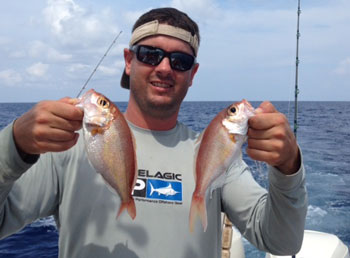 Snapper, Wenchman
Snapper, Wenchman
The Wenchman Snapper is a small, large-eyed fish that feeds primarily on fishes and are caught surprisingly often by anglers, who usually discard them because of unfamiliarity with the fish or their small size. The Wenchman averages 1 pound or slightly under, but can reach 3 pounds. Find the Wenchman in deep waters, from 80 feet to 1,200 feet deep over hard, low-relief bottoms, but they can be found on almost any bottom type except soft mud.
Blake L. caught these wenchman snapper off the Texas coast in over 700' of water.
 Snapper, Yellowtail
Snapper, Yellowtail
Yellowtail Snapper are found mostly in the southern Florida waters offshore near reefs and wrecks in waters deeper than 30 feet. In the Florida Keys you will find large schools of juvenile Yellowtail around inshore reefs. The Yellowtail travels in schools feeding on shrimp, worms, crabs and small fish. The Yellowtail is commonly caught from 12 inches to 16 inches with the large ones caught in waters over 100 feet. You can make our recipe Yellowtail Snapper Sand Balls to attract this excellent eating fish.
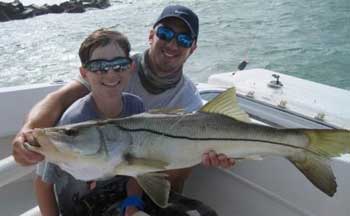 Snook
Snook
Snook can be readily found in bays usually around structures and in shallow water off beaches, but mostly in southern Florida. On the east coast, from Sebastian south you have great numbers of Snook, further north Snook are limited due to the colder waters. Snook cannot survive in water temperatures below 60 degrees.
Snook are excellent eating and fun to catch but do have strict catch limits and closures, so be sure to read up on current rules. They tend to feed two hours before sunrise and two to three hours after sunset with the best fishing during a tide change at these hours. One popular technique to catch Snook is to fish docks at night that have "snook lights" shinning into the water. Snook are drawn to the night lights as they take the opportunity to feed on shrimp that are drawn to the lights. Shrimp are by far the best bait for this elusive fish, especially when they come from the same waters as you are fishing. Some people use live pilchards with great success. Visit our Snook page for more info on snook.mage courtesy of Bouncers Dusky 33 - Miami Beach
 Spadefish, Atlantic (Chaetodipterus faber)
Spadefish, Atlantic (Chaetodipterus faber)
The strong fighting Atlantic Spadefish can be found on inshore structures like buoys or towers and on reefs. The Spadefish are normally caught at 10 pounds but can grow to 25 pounds and be 36 inches long.
Feeding on shellfish and jelly fish makes them excellent tablefare. For bait and chum use pieces of fresh mussels, clams and jellyfish.
See Billfish ID above
 Spearfish, Longbill
Spearfish, Longbill
Longbill Spearfish are found in deep offshore waters and can reach weights of 70 pounds. Often confused with the Marlin, this fish can be identified by their fin which is much higher throughout its length. This species feeds on the water surface and dines on small fish including dolphin, sauries, flying fish, needlefish and pilot fish, and squid. There is not a lot known of this fish, probably due to it's short lifespan of 5 years. This species is infrequently encountered by anglers.
 Spearfish, Mediterranean
Spearfish, Mediterranean
Like the Longbill Spearfish, The Mediterranean Spearfish is also infrequently encountered by anglers and usually only found in Mediterranean waters. The Mediterranean Spearfish is similar to the Longbill and matures at 2 years and has a lifespan of only 5 years.
 Spearfish, Roundscale
Spearfish, Roundscale
Nearly identical to the White Marlin, the Roundscale Spearfish differs in the distance between the anus and anal fin and has slightly rounder scales across portions of its body. Due to the difficulty of distinguishing these two species, the classification of the Roundscale Spearfish is not officially endangered, but being considered. It has been difficult to find information on this species as it was only identified in 2006. If you would like to read about the "mistaken identity" of both the White Marlin and the Roundscale Spearfish, check out this ScienceDaily article.
 Spot
Spot
Spot one of the most popular fish to be caught and eaten. It is usually between six and ten inches long. This is a schooling fish and is a good pier fishing target. They are usually found near oyster reefs or around pilings and jetties, but have been collected from all depths and bottom types. Spot love chum made with bloodworms, fish bites, pieces of cut fish, squid or shrimp. Image submitted by angler Larry Manion.
SQUID see section below
 Stingray, Atlantic
Stingray, Atlantic 
The Atlantic Stingray is the same fish common along the coast; they are the ones where we see signs to shuffle your feet to avoid getting stung. This species inhabits shallow coastal waters over sandy or silty bottoms, estuaries, and lakes and are common on the Atlantic and the Gulf of Mexico. It has been know to venture into brackish waters where it is called the Freshwater Stingray. This ray is one of the smallest stingray species, it attains a maximum length of 24 inches (61 cm) and a weight of 11 lb (4.9 kg). You will often see large schools swimming into bays during the spring and summer months in tropical waters. This stingray feeds on bivalves, tube anemones, amphipods, crustaceans, and Nereid worms. The Atlantic Stingray makes great bait for catching numerous species of sharks, such as the Hammerhead, Tiger and the Bull Shark.
To use the Atlantic stingray for bait, first remove the short poisonous spine with pliers that is at the base of it's long tail. Using very heavy line and large J hooks, thread a double hook system through the belly then through the mouth. The goal is for the stingray bait to appear to be swimming. You will catch very large fish with this setup, so be sure to use a heavy duty pole setup. Image Courtesy of NOAA Photo Library
 Stingray, Southern
Stingray, Southern
Image Courtesy of NOAA Photo Library
 Ray, Spotted Eagle
Ray, Spotted Eagle 
Spotted eagle ray's are spotted most often flying throught the air as in this photo. They are a beautifully colored ray with spots all over it's back. If you see a ray jumping out of the water, do not seek it out but turn and go the other way - they have been know to land in boats unexpectadly injuring people as they land. This ray does not have a stinger.
 Sturgeon
Sturgeon 
Sturgeon are native to subtropical, temperate and sub-Arctic rivers, lakes and coastlines. While some are entirely freshwater, very few venture into the open ocean beyond near coastal areas. Sturgeons range from 7?12 feet in length are common, and some species grow up to 18 feet. Most sturgeons are bottom-feeders, they use their projecting wedge shaped snout to stir up the soft bottom, and use the barbels to detect shells, crustaceans and small fish. They do not have teeth, so they must swallow their prey whole. Most species of sturgeons are considered at risk of extinction, making them more critically endangered than any other group of species. Sturgeon jump out of the water and can jump in your boat without warning, watch this FWC video. For more information on the Sturgeon visit FWC's Sturgeon page. Image Courtesy of FWC - 85-lb Sturgeon in the Blackwater River.
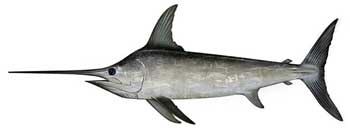 Swordfish
Swordfish
Swordfish are deep water dwellers found from the surface down to over 2,000 feet near the continental shelf. This powerful fish can be 200 pounds or more and give you the fight of a lifetime. The Swordfish feed on squid, fish and crustaceans. Swordfishing is primarily done at night when the Swords come close to the surface to feed. Chunk chumming works great with this species. Use heavy gear and 8/0 to 11/0 hooks with lights (to attract them) and balloons attached to detect a bite. Learn all about Swordfishing in Florida. Image courtesy of Florida Sea Grant
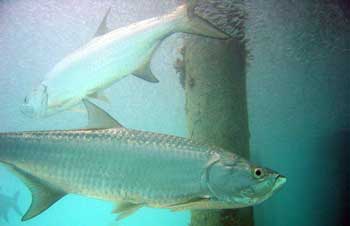 Tarpon (Megalops)
Tarpon (Megalops)
Tarpon are found in mostly in coastal waters and estuaries where the water is warm and shallow with sandy mud bottoms. In the Keys you can find Tarpon lurking around docks in large numbers and around seawalls. This large species is commonly 6 feet and over 100 pounds in south Florida and can get as large as 280 pounds. Often encountered solitary, they frequently travel in schools, especially in the Keys. Tarpon feed on stingrays, mullets, silversides, catfish, blue crabs, sardines, anchovies, and pinfish. They are a sought after species for sports fishing but make terrible table fare, so catch n' release is the game with this fish. Beware of the Great Hammerhead shark when reeling in Tarpon, this shark loves to steal your Tarpon catch.
To catch a 100 pound Tarpon you need heavy tackle: 100 pound test mono leader 10 feet long, hooks up to 7/0 (depends on your bait). Common bait used are blue crabs, pinfish, threadfin herring, mullet, grunts, and ladyfish. Most anglers use trolling motors to stalk the Tarpon.
Tarpon are famous for their aerobatics once hooked. In order to keep your catch hooked you must bow to the Silver King and lower your rod tip by pointing it at him when he goes airborne. Your slack line keeps your line from breaking and the hook in place.
You need a Tarpon stamp on your fishing license to catch a Tarpon, so be sure to get one if you plan on stalking this catch and release only fish. Florida regulations prohibit anglers from removing this species from the water if it is over 40 inches. Use circle hooks for easier release. And if you would like to help FWC, get a Tarpon DNA testing kit and keep it on your boat so you can take a sample and send it in for research. Tarpon Photo Courtesy of NOAA
 Tautog
Tautog
Tautog are typically encountered in North Atlantic waters, occassionally in the South Atlantic. They prefer waters within several miles of shore less than 60 feet deep, but have been found well offshore in 100 feet of water. Tautog are usually near cover, hovering around steep, rocky shorelines or hiding near wrecks, wharf pilings, piers, jetties, mussel and oyster beds, and bolder-strewn bottoms. The average Tautog is 2 to 4 pounds but they have been recorded to 22 pounds. The backs of their throats contain a set of teeth resembling molars which they use to pick and crush prey such as mollusks and crustaceans.
Threadfin, Atlantic (Polydactylus octonemus)
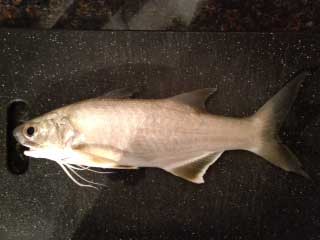
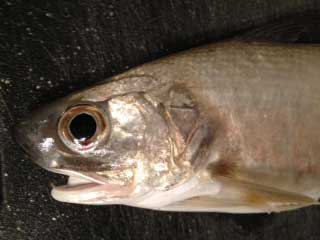 The Atlantic threadfin is a rare catch in Florida and has many names - threadfish, goatfish, surf runner, and glassnose whiting. The above pictures were of a 15 inch fish caught in the surf on Dania Beach. This species is found on all coasts of Florida through the Caribbean and primarily enhabits near shore waters with sandy or muddy bottoms, usually in the surf at the beach. More information on the Atlantic Threadfin.
The Atlantic threadfin is a rare catch in Florida and has many names - threadfish, goatfish, surf runner, and glassnose whiting. The above pictures were of a 15 inch fish caught in the surf on Dania Beach. This species is found on all coasts of Florida through the Caribbean and primarily enhabits near shore waters with sandy or muddy bottoms, usually in the surf at the beach. More information on the Atlantic Threadfin.
 Tidewater Silverside
Tidewater Silverside 
Tidewater Silverside is a bait fish found in schools in coastal waters and estuaries and is up to 6 inches in length. They are common in southern coastal waters.
 Tilefish, Blueline
Tilefish, Blueline
The Blueline Tilefish is a bottom dweller found in water ranging from 240-780 feet deep and is frequently found in the same habitat as groupers and snappers, preferring irregular bottom with sand, mud and shell hash. Blueline Tilefish feed on bottom creatures, such as crabs, shrimp, snails, worms, sea urchins and small fish. Image Courtesy of NOAA Photo Library - Photo taken Gulf of Mexico

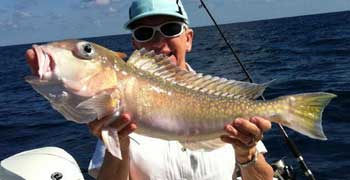 Tilefish, Golden
Tilefish, Golden
Golden Tilefish are found in deep offshore waters and feed during the day on the bottom on crustaceans, clams, snails, worms, anemones and sea cucumbers. Image courtesy of Bouncers Dusky 33 - Miami Beach
 Tomtate (Grunt)
Tomtate (Grunt) 
The Tomtate, also called Ruby Red Lips, Grunt or Spot Tail, is an bait fish for reef dwellers. The Tomtate can grow to 12 inches and weigh a pound and is ID'd by the inside of it's mouth being bright red. The Tomtate travels in large schools along rocky reefs. Since they inhabit deeper waters, use small baited hooks to catch them. Use the Tomtate as cut bait and for chunk chumming around reefs where they normally inhabit for Grouper or other reef fish. Photo Courtesy of MBARA, picture taken off Mexico Beach on MB-124
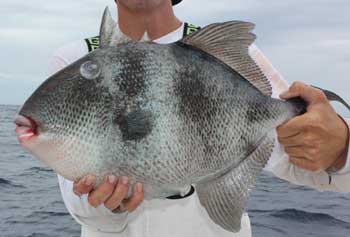 Triggerfish, Grey
Triggerfish, Grey
The Grey Triggerfish is found offshore near wrecks, reefs, rocks, and structures like oil platforms over hard bottom in 60 to 120 feet of water and are know as bait stealers. The average weight is 1 to 3 pounds, but they have been recorded at 14 pounds and can grow to 30 inches. The Grey Triggerfish feeds on shrimp, crabs, sea urchins, sand dollars, sea stars, sea cucumbers, and bivalve mollusks. The Triggerfish are excellent table fare with great tasting firm white flesh - remove it's tough skin and fillet.
Grey Triggerfish are known to be "bait stealers" commonly caught while fishing for snapper or grouper. The Grey Triggerfish will carefully nibble your bait with their sharp teeth leaving your with an empty hook! It takes a small hook and tough bait to actually land this tasty fish. FWC Image Courtesy of Last Mango Sportfishing Charters, Fort Pierce
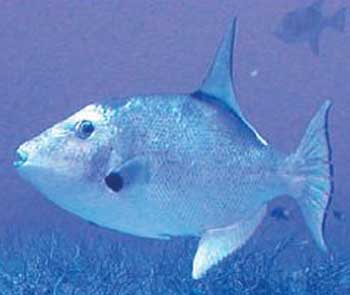 Triggerfish, Ocean
Triggerfish, Ocean
The Ocean Triggerfish is found offshore in open waters from 3 to 200 miles but sometimes near reefs, rocks, and structures. The Ocean Triggerfish is the largest of the Triggerfish growing to 2 feet in length and weighing an average of 2 to 5 pounds, rarely over 10 pounds. They eat primary large zooplankton, coral, and molluscs.
Courtesy of NOAA Photo Library
 Tripletail
Tripletail
The Tripletail is a surface fish, lounging around floating debris and buoys waiting for it's dinner to arrive. They can grow to 40 pounds but are normally found much smaller. They have very sharp teeth and spines with razors for gills, so handle with care. Tripletail feed on smaller fish, shrimp and crabs and are very good table fare. They are quite shy and slow to take your bait.
Photo Courtesy of MBARA, picture taken off Mexico Beach
![]() Check out NOAA's "A Guide to the Tunas of the Western Atlantic Ocean" for detailed information on identification of Tuna, protected species, and getting a reward for reporting the archival tagged bluefin tuna to your local fisheries agency.
Check out NOAA's "A Guide to the Tunas of the Western Atlantic Ocean" for detailed information on identification of Tuna, protected species, and getting a reward for reporting the archival tagged bluefin tuna to your local fisheries agency.
 Tuna, Albacore
Tuna, Albacore
Albacore Tuna is an offshore schooling fish found in the open tropical and temperate oceans. Schools can generally be found 10 miles offshore, look for birds diving on bait fish and you may find a school of tuna. This large fish can be up to 4 1/2 feet (140 cm) and weights up to 100 pounds (45 kg). Albacore are carnivores consuming schooling fish, such as sardine, anchovy, and squid. Chumming with a mix of anchovies or squid or chunk chumming with whole anchovy or parts works well.
 Tuna, Bluefin
Tuna, Bluefin
The Bluefin tuna is an offshore schooling fish that will aggregate and forage on concentrations of small pelagic prey like mackerel, sand lance, sea herring, menhaden and squid. Bluefin tuna follow the boat's chum line created by the shrimp boats by-catch, it is the world biggest chum line! March is a great time to follow the ship boats that are in full gear this time of the year. You can get some of the shrimp boat by-catch in exchange for some beer, just approach them when they are anchored. A 6-pack can get you a five gallon bucket or two. Now when you chum with this by-catch, you will surely have some great tuna action. Image courtesy of Bouncers Dusky 33 - Miami Beach
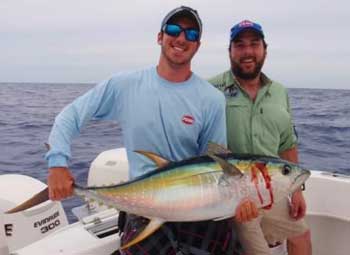 Tuna, Yellowfin
Tuna, Yellowfin
The Yellowfin Tuna are a schooling fish found offshore usually feeding on bait fish or squid. When you spot a school of jumping bait fish with diving birds get up current of the school and throw in chunks of sardines mixed with fish chum and let the chum drift to the bait fish. Cast your line into the cut bait and hold on tight, this is one powerful fish that can weigh 100 pounds. Use 80 pound line with a 100 pound leader with short shanked 9/0 hooks baited with fresh chunk bait. Be sure to have a lot of line on your heavy reel because once the Yellowfin Tuna is on your line they will dive straight down at amazing speeds. In order to keep a Yellowfin Tuna you must have a Highly Migratory Species Permit. The Yellowfin Tuna's meat is excellent on the grill or pan seared with wassabe. Image courtesy of Bouncers Dusky 33
 Wahoo
Wahoo
Wahoo are very fast, they can swim up to 50 mph and have been found at up to 8 feet in length, and weighing up to 180 lb. They can sometimes be found in small schools, but they mostly are solitary swimmers several feet below the surface not far from land in tropical and subtropical waters. Wahoo tend to be more active near sunrise and sunset. Wahoo are sought after as a sport fish for there speed and fighting ability, and for their excellent white fillets that have a delicate flavor. The Wahoo feeds on whole small fishes, such as sardines, scads, mackerel and squid. They will attack surface bait, so chunking is a great chum method using their preferred diner species. Most anglers hook up a Wahoo during heavy chumming while targeting other species. Image courtesy of Bouncers Dusky 33
 Clams
Clams 
Clams are bivalves that live in the sand at the waterline, the bottom of bays or on the ocean floor. They must be extracted with a shovel or clam rake. Many fish in the sea eat clams, as well as humans. While it may seem wasteful (most would rather eat the clam), they are excellent for making chum and fish bait. Some anglers use them whole and chunk chum. A great idea is to put clams, oysters, or mussels on the hook and freeze them individually. Keep them frozen until ready to use and they will stay on your hook. The clam juice is also an attractant.
Did you know Cedar Key is the nations top clam producers? Read this excellent article Life on the Half Shell about the clam industry.
CRABS 
Crabs are great eating and also great for bait. Many fish dine on crabs, so a chum mix with crushed crab makes for an excellent attractant. You can collect small crabs at the shore or you can use a crab trap to catch them. Crabs live in burrows on the beaches, look for the tell tale holes in the sand; some burrows can be a foot or more deep.
 Crab, Blue
Crab, Blue 
The Blue Crab is an excellent tasting crab that can grow their shell to almost 9 inches. The Blue Crab typically consume thin-shelled bivalves, annelids, small fish, plants and nearly anything else they find, including carrion, other blue crabs and human waste.
Blue Crabs are caught with traps baited with fish scraps. You can use small Blue Crabs as bait and eat the big ones. Use the carcasses for chum, just grind them up.
Visit BlueCrab.info for details on identification, trapping and details on making a your own crab trap.
 Crab, Blue Land
Crab, Blue Land 
The Blue Land Crab rarely ventures further than 5 miles from the coast. They live in burrows several feet deep. These crabs are primarily vegetarians, preferring leaves, fruits, berries, flowers and vegetables. Occasionally they will eat beetles or other large insects. Large groups of small Blue Land Crabs can be encountered on beaches and are easy to collect for you fishing bait. The larger varieties are great to eat, similar to the Blue Crab.
![]() Blue Land Crab Regulations
Blue Land Crab Regulations
Photo Courtesy of USFWS on Flickr:
 Crab, Fiddler (Uca pugnax)
Crab, Fiddler (Uca pugnax) 
The Fiddler Crab can be found in mangroves, salt marshes, and on sandy or muddy beaches. This very small crab is easily identified because the males have one large claw that they waves around to attract a mate. The are like ants running around the beach during low tides when they emerge in great numbers to feed. This small crab is only a few inches in length and they live in foot deep burrows on the beach. Fiddlers crabs make great bait for Redfish, Sheepshead, Black Drum and many other inshore species.
 Crab, Horseshoe
Crab, Horseshoe 
The horseshoe crab is not really a crab at all, it is actually a living fossil and is the oldest living relative of dinosaurs. The Horseshoe Crab lives in shallow salt waters on soft sandy or muddy bottoms and are common at the shoreline. Beware, there blood is blue! They have been abundant in the past, but in recent years their population has declined.
Learn all about the horseshoe crab on our The Amazing Horseshoe Crab webpage.
Crab, Rock (Mud Crab) 


Rock crab's are commonly found scurrying on jetties, docks, bridge pilings, rocks, and man made rip rap. Rock crabs are very dark in color, nearly black or a dark gray in color. They make excellent bait for sheepshead and mangrove snapper. Catching them can be a chore because they are very quick. Gloves are necessary as these crabs will pinch you once caught and you will be grabbing them on surfaces covered with sharp barnacles. Set your hook by pushing the point through the shell between the back legs so the crab doesn't die and it can still swim.
Image #1 submitted by Manne H. taken in Punta Gorda, FL
Image #2 taken in the Florida Keys by M. Busch

Mud crabs and stone crabs inhabit the same areas. To distinguish a small stone crab from a mud crab, juvenile stone crabs have stripes on their legs and spots on their shell. To learn more visit Florida Sea Grant.
 Crab, Stone
Crab, Stone
Stone Crabs live at the bottoms of bays, grass flats, oyster reefs, and rock jetties. Stone Crabs feed on oysters, polychaete worms, and other crustaceans, occasionally eating seagrass and dead fish. They are excellent table fair. Many areas have strict rules on harvesting this crab, so please know the rules before harvesting.
Photo Courtesy of MBARA, picture taken off Mexico Beach

 Lobster, Spiny (Crayfish)
Lobster, Spiny (Crayfish) 
The Spiny Lobster is found all over Florida but is more abundant in the lower tropical waters around structures both near shore and offshore. The Spiny Lobster feeds on snails, clams, crabs, sea urchins or carrion. Spiny Lobsters navigate using their antennae while smelling and tasting there way along the bottoms and bottom structure. To see a parade of Spiny Lobsters following each other across the ocean floor is a spectacular site. The only edible part on this Lobster species is it's tail; use the discarded body for fish chum; Snappers especially go crazy for the scent of the Spiny. There are almost a dozen species of Lobster residing in Florida water, learn all about the different Lobster species and Lobstering on our Lobstering page.
 Mussels
Mussels 
Mussels are great bait and abundant along the shore line clinging to rocks in the surf. They have beards that are used to attach them to a structure so they are not washed away in the surf. You can collect a bucket full and grind them up for chum or eat them!
 Pen Shells (Pinnidae)
Pen Shells (Pinnidae)
You may find a pearl in this triangular shaped mollusk! Pen Shells are large clams with very fragile shells that live on the bottom of the sea floor submerged in the soft sand, pointy end down, with a few inches showing above the surface. Pen Shells feed on starfish and conch.
They are very popular in the Panhandle, collected and prepared as you would a Scallop and are said to taste better than the Scallop. Make a Pen Ceviche or use the Pen Shell in recipes calling for Scallops. In southern Florida they are usually found broken so it is less common to hear they are collected for food.
Source: http://www.mollusks.croar.net/view:44
 Sand Fleas (Mole Crab)
Sand Fleas (Mole Crab) 
Sand Fleas are not insects but 1 1/2 inch long crustaceans that live in the sand. They live in colonies around 2 feet across and 10 feet long paralleling the beach. Sand Fleas are popular surf fishing bait. They can be easily collect from the sand using a Sand Flea Rake or a shove. If you find a lot you can grind them up for chum. You can buy a Sand Flea Rake on our Store Bait Catching page.
 Scallops, Florida Bay
Scallops, Florida Bay 
Bay Scallops can be found across the state from Palm Beach on the east coast to Pensacola on the west coast. The most popular destinations for recreational scallopers are Steinhatchee, Crystal River and Homosassa. Florida bay scallop, a bivalve mollusk, grows and lives in the shallow seagrass beds 4 to 10 feet deep. Recreational scallop season runs from July 1st to September 10th each year and you only need a saltwater fishing license to scallop. You can use the unwanted soft parts of the scallop for chum or bait. For more information click here for the Recreational Harvesting of Florida Bay Scallops in Citrus County. Visit our Scalloping page for detailed information on Scalloping in Florida. Image Courtesy FWC
 Shrimp
Shrimp 
There are many varieties of Shrimp, both freshwater and saltwater around the world, that live close to the bottom, but are frequently found drifting on the surface with the tide. Shrimp are filter feeds that live in schools and can swim rapidly backwards. They are the world's most famous bait and are an important food source for both marine creatures and humans. Shrimp can be caught with a shrimp net or cast net, see our Live Bait page for more info.
To learn about Florida shrimp and shrimp fisheries, visit Collier Sea Grant.
 Squid
Squid 
There are over 300 species of squid worldwide with most species under 2 feet in length. Squid often swims in schools, eating small fish, shrimp, and crustaceans. Squid is know as "candy bait" because most any fish will go after squid, dead or alive.
Squid live at the bottom of the sea during the day and propel upwards at night. Squid will often school on the edge of a reef or grass bed to ambush prey.
The best time to catch squid is dusk to dawn on an incoming and slack tide?squid are attracted to lighted water, so look for them under a lighted bridge, pier or dock or supply your own light. Around the world it is very popular to fish for squid using tipped jigs on lines. In Spain it is considered a national past time; in Australia anglers target an abundant large species of squid.
 Like the octopus, it emit's an inky substance when threatened and it has the ability to change it's color to blend in with its environment. Netting a school of squid is a popular means when you find a large school. Remember, squid swim backwards, so you must cast your net behind them. Also remember to slightly tilt the net so when the squid expels its ink it is dispersed into the water.
Like the octopus, it emit's an inky substance when threatened and it has the ability to change it's color to blend in with its environment. Netting a school of squid is a popular means when you find a large school. Remember, squid swim backwards, so you must cast your net behind them. Also remember to slightly tilt the net so when the squid expels its ink it is dispersed into the water.
Not only are squid popular table fare, they are a tough, versatile bait for fishing and can be used in your chum mix. Squid wings are a by-product and can be purchased inexpensively ($20 for 50 lbs) in bulk for making an excellent chum; just grind the wings up.
Squid is so enticing to fish that professional sport fisherman will go so far as to paint squids on the bottoms of their boats because they are not allowed to chum during tournaments. Live Squid - photo taken in the Caribbean by Carol Cox
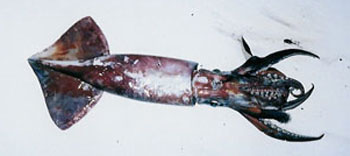 Squid, Atlantic Longfin
Squid, Atlantic Longfin 
Atlantic longfin squid are found generally offshore near the continental shelf close to sandy or muddy bottoms. Seasonally they come inshore to breed. Adults average a foot long but can get over 1 1/2 feet in length. Young feed on plankton, adults feed on shrimp and small fish.
The 2 foot Atlantic longfin squid to the left was caught off Key West by Outerlimits Sportsfishing < click to see a bigger picture of this squid.
 Squid, Longfin Inshore
Squid, Longfin Inshore 
The longfin inshore squid is abundant in the north Atlantic waters but can be found off Florida's coast near the continental shelf. This species lives only a year, replenishing it's stock every 6 months due to the fact that it continually spawns. Juveniles can be found in the upper water columns about 150 feet, adults can be found as deep as 1600 feet. This squid is popular food for whales and dolphins. The longfin inshore squid can grow to about 1 1/2 feet. Adults feed on fish and they are very aggressive hunters; a school of longfins can descimate an entireschool of herring!
Image courtesy of NOAA Photo Library - photo taken Gulf of Mexico
 Worm, Lugworm (Arenicola cristata)
Worm, Lugworm (Arenicola cristata) 
Lugworms's have a thicker tougher skin and leave a tell tail yellow stain on your hand when you are putting them on the hook. Lugworms can grow from 3 to 12 inches. They live in a U-shaped burrow in sand on most beaches. They are a popular bait and used to make chum cocktails.
They are collected at the beach with a shovel or pitch fork rake. Look for mounds of sand about 6 inches apart and the worm should be in its U-shaped hole between the two mounds. Dig a few inches away from the mounds all the way around to extract the worms. Put the worms in a bucket and add a bit of seaweed to keep them damp. To store them, put in a fridge wrapped in newspaper or they can be frozen.
 Worm, Ragworm
Worm, Ragworm 
Marine worms are an important food source for birds, fish, and invertebrates. The Ragworm can be red or white and have 2 pincers so you need to be a little careful when preparing them. The white variety is popular for catching Cod fish in the U.K. where they use them to "tip their cocktail" or whole as bait. The red variety is usually produced commercially so there is a great supply of them. It is popular to use the Ragworm for surf casting or fishing from the shore.
![]()
CONSUMPTION ADVISORY: All individuals should follow Department of Health (DOH) guidelines. Florida Fish Eating Advisories Saltwater species also have warnings on page 27.














